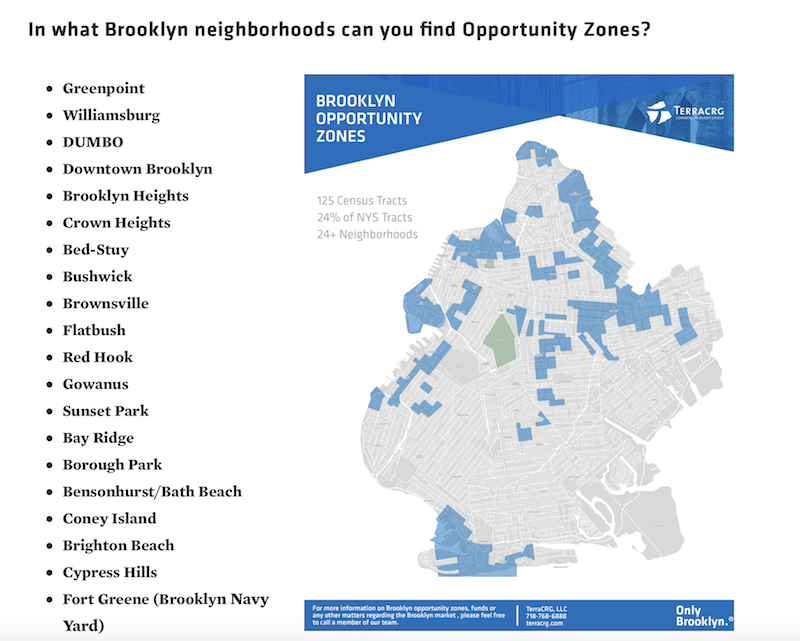On Wednesday, the U.S. Treasury Department and the Internal Revenue Service released new regulations and guidelines for investments in the 8,700 distressed or lower-income census tracts that governors across the country have designated as Opportunity Zones (OZs).
The new regulations, which expand upon the initial round that came out last October, are meant to provide greater clarity for investors and developers about how funds raised for such investments might qualify for tax breaks.
“This round of regulations removes some of the most significant impediments keeping capital on the sidelines, especially as it relates to operating businesses,” John Lettieri, president of the Economic Innovation Group, a Washington research organization that developed and championed the Opportunity Zone concept, told the New York Times.
The new round of regs is timely, as the maximum tax benefit of the legislation requires an Opportunity Zone investment be completed by December 31.
While the federal government has projected $100 billion in Opportunity Zone investments, some developers so far have held back from jumping into this program—which was part of the tax overhaul that Congress approved in 2017—because of uncertainties about qualifications of both buildings and businesses to invest in.
The logic behind OZs is that wealth generated by capital gains could be better used for investments in neighborhoods that typically lack access to that money for redevelopment. The goal of OZs is to spur economic growth. But some skeptics had contended that the program’s regulatory structure was too lax, and that the government, through tax breaks, would end up subsidizing developments in areas that were already attractive to investors.
There are also concerns about gentrification, as the Opportunity Zone concept hasn’t always worked as intended, or at least to the direct benefit of low-income residents. Zillow Economic Research reported in March that prices for homes within Opportunity Zones rose by 25.3% last year, versus 8.4% for census tracts that were eligible but not selected as OZs, and 2.5% for tracts not eligible.
HUD’s Secretary Ben Carson told The Real Deal last month that his agency cannot mandate affordable housing in the zones. It will, however, give preference for developers who apply for certain federal grants to build affordable housing within Opportunity Zones.
Money flowing to Opportunity Zones has mostly gone toward real estate investments, particularly on both coasts. Treasury Secretary Steven Mnuchin has emphasized that the program is also geared toward other types of businesses as well.

The New York City borough of Brooklyn is where New York State has designated 125 of its 514 Opportunity Zones. Nationwide, governors have designated 8,700 OZs. Image: TerraCRG
The new regulations spell out in greater detail the program’s investment and tax-break mechanism.
For one thing, new regulations create tax benefits for leased property, according to Law.com. Investors essentially can take their capital gains from any venture, real estate or otherwise, and put them into a qualified opportunity zone fund that then, likely through a fund manager, seeks eligible projects. The earlier version gave investors 180 days from the date they realized capital gains to put the money into an opportunity zone fund. If they keep their money in the fund for five years, 10% of their deferred gain is eliminated. An additional 5% of their capital gains would be untaxed if they keep their money in the fund for seven years.
The biggest tax benefit from this program accrues to investors and developers who hold their money in an Opportunity Zone for at least a decade. By doing so, they forgo paying tax on capital gains from those investments altogether.
Opportunity Funds raised by investors get a 12-month grace period to sell assets in Opportunity Zones and then reinvest those proceeds in the Zone. There was some concern previously that this reinvestment had to be made immediately.
The Times reports that investors will be allowed to share their stakes in funds that invest in the zones, and to sell, say, a start-up in an Opportunity Zone as long as the money is reinvested in another qualifying business or asset. Real estate investors will be allowed to lease and refinance their properties.
However, the proposal also allows Treasury officials to revoke a tax break for any Opportunity Zone project “if a significant purpose of a transaction is to achieve a tax result that is inconsistent with the purposes” of the program.
Investors have been concerned about earlier guidance that stated a business that wanted to qualify for the Opportunity Zone program had to derive at least half of its gross income from the Zone itself. Joshua Pollard, a contributing writer for Forbes, points out that the new guidance assuages those concerns by creating four distinct tests for businesses to qualify:
•Total hours worked by employees or independent contractors in a Zone must equal at least 50% of the company’s total hours worked;
•Half of total dollars paid to those employees or contractors must be for services performed in the Zone. The Times reports that provisions in the new regulations allow investors to qualify for tax breaks even if the businesses they fund export goods or services, or if the domestic market for those goods is outside of the zone.
•A business’s management and operational staff, and the tangible property of the business, that are in the Opportunity Zone must be essential to at least half of the business’s gross income; and
•A fourth, intentionally ambiguous, category, “Facts and circumstances,” leaves a lot of wriggle room for businesses to make their case to the IRS, says Pollard.
Pollard notes that outside of the 169-page guidance document, the White House Opportunity and Revitalization Council, made up of nearly 20 federal agencies, has added so-called “preference points,” or tie-breaker considerations, for projects and applicants in Opportunity Zones this year, with the explicit goal of eliminating federal bureaucracy. Ultimately this could give a leg up to as many as 150 programs.
Related Stories
Green | Dec 9, 2022
Reaching carbon neutrality in building portfolios ranks high for organizations
Reaching carbon neutrality with their building portfolios ranks high in importance among sustainability goals for organizations responding to a Honeywell/Reuters survey of senior executives at 187 large, multinational corporations. Nearly nine in 10 respondents (87%) say that achieving carbon neutrality in their building portfolio is either extremely (58%) or somewhat (29%) important in relation to their overall ESG goals. Only 4% of respondents called it unimportant.
Green | Dec 9, 2022
Newly formed Net Zero Built Environment Council aims to decarbonize the built world
Global management consulting firm McKinsey recently launched the Net Zero Built Environment Council, a cross-sector coalition of industry stakeholders aiming to decarbonize the built world. The council’s chief goal is to collaboratively create new pathways to cut greenhouse gas emissions from buildings.
Energy Efficiency | Dec 6, 2022
Washington state’s Building Code Council mandates heat pumps in all new residential construction
The Washington State Building Code Council has voted to require heat pumps for all new residential construction starting in July 2023. The new mandate has drawn criticism over concerns that it will add costs to housing construction, especially given current supply chain challenges for heat pumps.
Geothermal Technology | Dec 6, 2022
Google spinoff uses pay-as-you-go business model to spur growth in geothermal systems
Dandelion Energy is turning to a pay-as-you-go plan similar to rooftop solar panel leasing to help property owners afford geothermal heat pump systems.
Contractors | Dec 6, 2022
Slow payments cost the construction industry $208 billion in 2022
The cost of floating payments for wages and invoices represents $208 billion in excess cost to the construction industry, a 53% increase from 2021, according to a survey by Rabbet, a provider of construction finance software.
Multifamily Housing | Dec 6, 2022
Miami-Dade County will allow accessory dwelling units
Commissioners in Miami-Dade County, Fla., recently voted to allow many single-family homeowners to rent out accessory dwelling units on their property. Many homeowners will be allowed to rent out garages, separate quarters, or detached backyard apartments if they meet certain standards including for lot size and parking.
Multifamily Housing | Dec 6, 2022
Support for multifamily rent control legislation grows as metros face big rent hikes
Steep rent increases during the pandemic recovery have spurred support for rent control legislation in several areas of the country.
Mass Timber | Dec 1, 2022
Cross laminated timber market forecast to more than triple by end of decade
Cross laminated timber (CLT) is gaining acceptance as an eco-friendly building material, a trend that will propel its growth through the end of the 2020s. The CLT market is projected to more than triple from $1.11 billion in 2021 to $3.72 billion by 2030, according to a report from Polaris Market Research.
Retail Centers | Nov 29, 2022
'Social' tenants play a vital role in the health of the retail center market
After a long Covid-induced period when the public avoided large gatherings, owners of malls and retail lifestyle centers are increasingly focused on attracting tenants that provide opportunities for socialization. Pent-up demand for experiences involving gatherings of people is fueling renovations and redesigns of large retail developments.
Multifamily Housing | Nov 29, 2022
Number of office-to-apartment conversion projects has jumped since start of pandemic
As remote work rose and demand for office space declined since the start of the Covid-19 pandemic, developers have found converting some offices to residential use to be an attractive option. Apartment conversions rose 25% in the two years since the start of the pandemic, with 28,000 new units converted from other property types, according to a report from RentCafe.

















